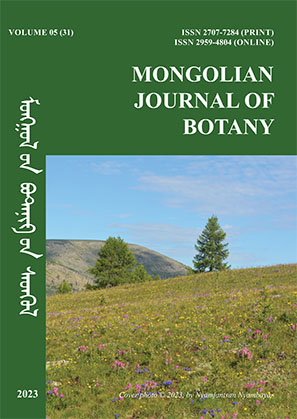Study on the products of technology “Tenuun” tea
DOI:
https://doi.org/10.5564/mjb.v5i31.3269Keywords:
total flavonoid, total phenolic compounds, antioxidant activity, MNS standardAbstract
We had chosen the Glycyrhizia uralensis Fisch, Thymus gobicus Tczern, Thermopsis lanceolate R.Br, and Chamaenerion angustifolium L. as a biological supplement based on traditional and modern medical knowledge. In order to develop the (Tenun tea) technology, tea has been divided into seven different variations based on its clinical characteristics, and biologically active compounds were determined along with the standard of drug pharmacopeia method.
As a result, variation IV was chosen, because of the most appropriate and it was determined that it corresponded with the MNS 5131:2002, MNS 5743:2007, and MNS ISO 4286:2000 standards of national tea standard. In a laboratory under expert supervision, tea samples were microbiologically analyzed in 2022 to determine whether they conformed to cleanliness standards. The procedure of tea technology was established, the tea production scheme was purified and packaged, the tea box and packaging design were made, the product model was produced, the bar code was confirmed, and after all these procedures, the tea already entered the trademark, also intellectual property patent was submitted.
This tea has plenty of advantages, which are made of medicinal plants used in traditional medicine, is a research-based herbal product with benefits for the lungs, expectoration, clearing of airway or throat irritation, antibacterial and virus activity, as well as a protective effect against colds and the flu.
“Тэнүүн” цай гарган авах технологийн судалгаа
Хураангуй: Бид уламжлалт мэдлэгт тулгуурлан цэр ховхолж, хий ханиалга намдаах, амьсгалын замыг цэвэрлэх үйлдэлтэй мөн бактер, вирусын эсрэг идэвхтэй байгалийн ургамлууд болох Урал чихэр өвс (Glycyrhizia uralensis Fisch) Говийн ганга ( Thymus gobicus Tczern), Юлдэн тарваганшийр (Thermopsis lanceolate R.Br), Нарийннавчит хөвөноройт (Chamaenerion angustifolium L.) ургамлуудыг сонгон авч, ханиад томууны үед эмчилгээнд хэрэглэх, урьдчилан сэргийлэх үйлдэл бүхий биологийн нэмэлт бүтээгдэхүүн болох “Тэнүүн цай”-г гарган авлаа. Үүний тулд эдгээр 4 зүйл эмийн ургамлын ашиглагдах хэсгийг хатаан нунтаглаж, 7 хувилбараар хольж найруулан, биологийн идэвхт нэгдлийг эмийн фармокопейн стандарт арга зүйн дагуу хийж гүйцэтгэсэн. Ингэхэд IV хувилбар нь хамгийн тохиромжтой бөгөөд цайны MNS 5131:2002, MNS 5743:2007, MNS ISO 4286:2000 стандартад нийцэж байгааг тогтоолоо. Цайны дээжийг 2022 онд мэргэжлийн хяналтын ХАБҮЛабораторид микробиологийн шинжилгээнд хамруулж, эрүүл ахуйн шаардлага хангаж буйг тодорхойлуулав. Үүний дараа цайны технологийн горимыг тогтоож, цай үйлдвэрлэлийн схемээр ариутган савлаж, цайны хайрцаг, сав баглаа боодлын дизайныг гарган, үйлдвэрлэлд нэвтрүүлэх бүтээгдэхүүний загварыг гарган авлаа. Бүтээгдэхүүний бар кодыг баталгаажуулан, барааны тэмдэгт болон оюуны өмчийн патентийг мэдүүлээд байна.
Түлхүүр үгс: нийлбэр флавоноид, нийт фенолт нэгдэл, антиоксидант идэвх, MNS стандарт
Downloads
1947
References
Abraham J., Florentine S. 2021. Licorice (Glycyrrhiza glabra) Extracts-Suitable Pharmacological Interventions for COVID-19. A Review. Plants, 10: 2600. https://doi.org/10.3390/plants10122600.
Keskin-Sasic., Tahirovic, Topcagic, Klepo, Salhovic, Ibragic, Toromanovic, Ajanovic, Velispahic. 2012. Total phenolic content and antioxidant capacity of fruit juices. Bulletin of the Chemists and Technologists of Bosnia and Herzegovina. Original Scientific Article. 25-28.
Lu van de Sand L., Bormann M. Alt M., Schipper L., Heilingloh C.S., Steinmann E., Todt D., Dittmer U., Elsner C., Witzke O. 2021. Glycyrrhizin Effectively Inhibits SARS-CoV-2 Replication by Inhibiting the Viral Main Protease. Viruses. 13: 609. https:// doi.org/10.3390/v13040609
Narasimhansreevidya. Shantamehrotra. 2003. Spectrophotometric method for estimation of alkaloids precipitable with Dragendorff’s reagent in plant materials. Journal of aoac international. Vol. 86: 6.
Pharmacopoeia. 2015. Pharmacopoeia of the People’s Republic of China. Pharmacopoeia of the P. R. China. Vol. 1. China Medical Science Press. Beijing, pp. 320-321.
Sadiq A, Hayat MQ, Mall SM. 2014. Qualitative and Quantitative Determination of Secondary Metabolites and Antioxidant Potential of Eruca sativa. Nat Prod Chem Res. 2:137. doi:10.4172/2329-6836.1000137
Shu Zhu 1., Reiko Sugiyama., Javzan Batkhuu., Chinbat Sanchir., Kun Zou., Katsuko Komatsu. 2009. Survey of Glycyrrhizae Radix resources in Mongolia: chemical assessment of the underground part of Glycyrrhiza uralensis and comparison with Chinese Glycyrrhiza Radix. J Nat Med. 63:137- 146. https://doi.org/10.1007/s11418-008-0303-7
The Society of Japanese Pharmacopoeia. 2001. Japanese Pharmacopoeia, (15th ed., Eng.). Ministry of Health Labor and Welfare of Japan, Tokyo.1197
Гринкевич Н.И., Л.Н. Сафронич. 1983. Химический анализ лекарственный растений подред. 41-48, 82-103, 120-142.
Сүхдолгор Ж. Ургамлын хими, биохими дадлагын хичээлийн гарын авлага. 2013. Улаанбаатар. 37, 137.
У. Лигаа. 2015. Монгол орны эмийн ургамлыг өрнө дорнын анагаах ухаанд хэрэглэхүй. УБ. IMUNAL, 487. 435-436, 318-320, 122-123.
Downloads
Published
How to Cite
Issue
Section
License
Copyright (c) 2023 Batzaya Gachmaa, Azzaya Jukov, Indree Tuvshintogtokh

This work is licensed under a Creative Commons Attribution 4.0 International License.
The authors grant the Mongolian Journal of Botany a license to publish the article and identify itself as the original publisher.

Articles in the Mongolian Journal of Botany are Open Access articles published under a Creative Commons Attribution 4.0 International License CC BY.
This license permits use, distribution and reproduction in any medium, provided the original work is properly cited.




